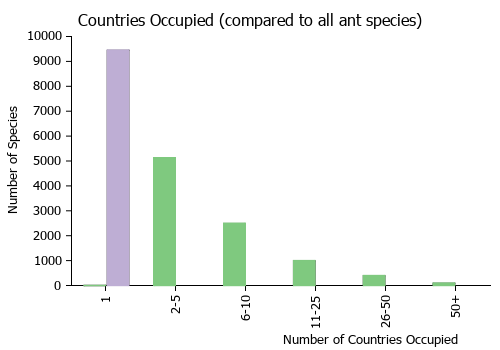Formica pacifica
| Formica pacifica | |
|---|---|

| |
| Scientific classification | |
| Kingdom: | Animalia |
| Phylum: | Arthropoda |
| Class: | Insecta |
| Order: | Hymenoptera |
| Family: | Formicidae |
| Subfamily: | Formicinae |
| Tribe: | Formicini |
| Genus: | Formica |
| Species: | F. pacifica |
| Binomial name | |
| Formica pacifica Francoeur, 1973 | |
Formica pacifica is a brightly coloured species of Formica occupying the west coast of the United States and Canada. This species is a host for the temporary social parasite Formica obscuripes, and potentially more temporarily parasitic and slave raiding Formica species (J. Roth, pers. comm., 2019).
Identification
Keys including this Species
- Key to Nearctic Formica fusca group males
- Key to Nearctic Formica fusca group queens
- Key to Nearctic Formica fusca group workers
Distribution
Latitudinal Distribution Pattern
Latitudinal Range: 49.11° to 36.35°.
| North Temperate |
North Subtropical |
Tropical | South Subtropical |
South Temperate |
- Source: AntMaps
Distribution based on Regional Taxon Lists
Nearctic Region: United States (type locality).
Distribution based on AntMaps
Distribution based on AntWeb specimens
Check data from AntWeb
Countries Occupied
| Number of countries occupied by this species based on AntWiki Regional Taxon Lists. In general, fewer countries occupied indicates a narrower range, while more countries indicates a more widespread species. |

|
Estimated Abundance
| Relative abundance based on number of AntMaps records per species (this species within the purple bar). Fewer records (to the left) indicates a less abundant/encountered species while more records (to the right) indicates more abundant/encountered species. |

|
Biology
Reproduction
Alate brood is produced after hibernation, and, in British Columbia, nuptial flights occur from July to the middle of September (on particularly warm days). Male sexuals are released first, in the early afternoon. Female alates fly soon after. Dealate queens often overwinter before laying their first eggs.
Nesting Habits
Unlike most species from the F. fusca group, Formica pacifica colonies prefer their nests moderately dry. Pupae are stored at the top of the nest, often underneath a rock or another solid surface. Larvae and eggs are usually stored deeper underground, in the additionally moistened parts of the nest.
Foraging/Diet
Formica pacifica collects honeydew. These ants are also scavengers, primarily collecting dead arthropods. Dead, dried out worms are collected in particularly high numbers. Foraging activity primarily occurs in the daytime, with the peak amount of workers dispatched in the afternoon. These ants generally forage alone, but will form trails to plants containing aphids. Once food is found, workers will often recruit others to help feed, or pull food back to the nest.
Flight Period
| X | |||||||||||
| Jan | Feb | Mar | Apr | May | Jun | Jul | Aug | Sep | Oct | Nov | Dec |
Source: antkeeping.info.
- Check details at Worldwide Ant Nuptial Flights Data, AntNupTracker and AntKeeping.
 Explore: Show all Flight Month data or Search these data. See also a list of all data tables or learn how data is managed.
Explore: Show all Flight Month data or Search these data. See also a list of all data tables or learn how data is managed.
Association with Other Organisms
 Explore: Show all Associate data or Search these data. See also a list of all data tables or learn how data is managed.
Explore: Show all Associate data or Search these data. See also a list of all data tables or learn how data is managed.
This species is a host for the temporary parasite Formica obscuripes in British Columbia, Canada (J. Roth, pers. comm., 2019) and is enslaved by Polyergus mexicanus (Trager, 2013; de la Mora et al., 2021).
Castes
Nomenclature
The following information is derived from Barry Bolton's Online Catalogue of the Ants of the World.
- pacifica. Formica pacifica Francoeur, 1973: 131, figs. 190-197 (w.q.) U.S.A.
Unless otherwise noted the text for the remainder of this section is reported from the publication that includes the original description.
Description
References
- Bolton, B. 1995b. A new general catalogue of the ants of the world. Cambridge, Mass.: Harvard University Press, 504 pp. (page 200, catalogue)
- Borowiec, M.L., Cover, S.P., Rabeling, C. 2021. The evolution of social parasitism in Formica ants revealed by a global phylogeny. Proceedings of the National Academy of Sciences 118, e2026029118 (doi:10.1073/pnas.2026029118).
- de la Mora, A., Sankovitz, M., Purcell, J. 2020. Ants (Hymenoptera: Formicidae) as host and intruder: recent advances and future directions in the study of exploitative strategies. Myrmecological News 30: 53-71 (doi:10.25849/MYRMECOL.NEWS_030:053).
- Francoeur, A. 1973. Révision taxonomique des espèces néarctiques du groupe fusca, genre Formica (Formicidae, Hymenoptera). Mém. Soc. Entomol. Qué. 3: 1-316 (page 131, figs. 190-197 worker, queen described)
References based on Global Ant Biodiversity Informatics
- Blacker, N.C. 1992. Some Ants from Southern Vancouver Island, British Columbia. J. Entomol. Soc. Bri. Columbia 89:3-12.
- Blacker, N.C. 1992. Some ants (Hymenoptera: Formicidae) from Southern Vancouver Island, British Columbia. Journal of the Entomological Society of British Columbia 89:3-12
- Francoeur. A. 1973. Revision taxonomique des especes nearctiques du group fusca, genre Formica. Memoires de la Societe Entomologique du Quebec 3: 1-316.
- Johnson R. Personnal Database. Accessed on February 5th 2014 at http://www.asu.edu/clas/sirgtools/resources.htm
- Longino, J.T. 2010. Personal Communication. Longino Collection Database
- Parson G. L., G Cassis, A. R. Moldenke, J. D. Lattin, N. H. Anderson, J. C. Miller, P. Hammond, T. Schowalter. 1991. Invertebrates of the H.J. Andrews Experimental Forest, western Cascade Range, Oregon. V: An annotated list of insects and other arthropods. Gen. Tech. Rep. PNW-GTR-290. Portland, OR: U.S. Department of Agriculture, Forest Service, Pacific Northwest Research Station. 168 p.
- Ward P. S. 2005. A synoptic review of the ants of California (Hymenoptera: Formicidae). Zootaxa 936: 1-68.


